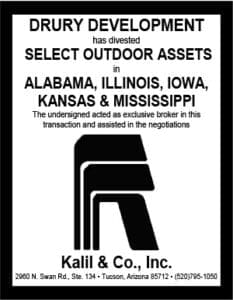
Many readers know that my background is in commercial real estate. What they may not know is that I started my career with the Maricopa County Assessor’s office appraising commercial real estate for tax assessment (or equalization). Those were lean earning years, but I loved the analytical office work and getting out of the office to look at new buildings popping up all over Phoenix.
You might have noticed that the Maryland Court of Appeals recently upheld two lower courts in supporting a new Baltimore Billboard Tax. I skimmed through the court’s decision and a few things struck me. For one, the City developed this new tax based on a need for revenue (obviously) and they did it based on (what seems to me) an arbitrary tax rate. Baltimore decided to charge $15 per square foot of Digital Display area and $5 per square foot of Vinyl Display area. But, why $15 and $5 per square foot? Why not $8 and $2 per square foot. Or why not $30 and $10 per square foot? Are they assessing the value of on-premise signs based on a price per square foot? This means that a double sided 14×48 foot Digital Bulletin will be taxed at a rate of $20,160 per year. If the sign generates $300,000 per year in revenue, that’s about 6.72% annually. If a double sided Vinyl Poster generates $20,000 per year and is taxed at $5 per square foot (or $3,000 per year), that’s about 15% annually. This seems fraught with inequity.
For another thing, I didn’t see any discussion of how this tax was related to the way other real estate or personal property interests are taxed in Baltimore. Equalization is defined by Merriam-Webster as the burden to…
“make uniform especially : to distribute evenly or uniformly // equalize the tax burden.”
As a young commercial real estate appraiser for the County, we were constantly reminded that the way we estimated values should be consistent, equal and based on sound reason – “fair.” I get the sense that “equalization” was not even considered by the City of Baltimore or by Clear Channel, for that matter, in their legal arguments for or against the tax. If other real property or personal property in Baltimore is being taxed based on the depreciated cost to construct these kinds of assets, why wouldn’t Clear Channel insist that their sign structure valuations be based on a similar depreciated cost formula.
We are not attorneys, but it seems like a Free Speech / First Amendment Challenge was misguided. We don’t think that making value estimates for a tangible asset has anything to do with the right to free speech or the content of that speech. However, tax assessment has everything to do with fairness and being equal in terms of the approach taken.
SignValue uses proprietary online software to estimate the depreciated cost of structures. SignTally‘s estimates are based on the depreciated cost of building sign structures and digital displays. Quick disclaimer: the mobile app is no longer offered or supported.
Let us know if we can help you estimate the depreciated cost of your billboard structures and displays.
Paul Wright, Analyst

[wpforms id=”9787″]
Paid Advertisement


















We had the same issue with a local city in Los Angeles County maybe twenty-give years ago. We prepared a complaint based on a combination of 1st Amendment and valuation points. After we showed the complaint to to the city’s attorney, we’re were able to negotiate a reasonable business-license tax without actually filing the case.
If you think it would be helpful, I would be happy to comment. Basically, the 1st Amendment discussion ties in directly with Paul’s comments.
P.S. Several years later, the same local city hired us to re-write it’s local sign ordinance.